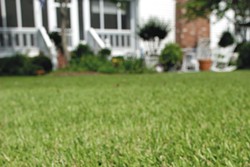Although it’s true that core aeration relieves soil compaction in the lawn, coring has several more benefits for the grass plant soil profile, microbial activity in the ground and thatch management.
When the soil beneath the lawn is compacted, grass roots grow poorly. They stay nearer to the surface and are more readily affected by droughts. Coring allows the soil to relax and expand into the vacated core. To encourage deeper roots, the core allows more soil oxygen into the profile along with water. Both of these promote deeper rooting of your lawn grasses, which allow better disease resistance, for example.
Another benefit is the lawn’s ability to remain green and actively growing during a brief drought. If any topdressing is done with quality black dirt or using well-composted organic matter, this material will find its way into the core as well, improving the soil profile. Any kind of organic matter will also support the microbial life in the ground, improving the symbiotic relationship between the grass root system and the microbes in the soil. Research shows that if the soil is in good health with teaming microbial activity, it in turn supports good grass growth by providing critical elements to the grass plant.
Core aeration can also maintain thatch levels under one-half inch.
Homeowners hear the word ‘thatch’ and often think the worst. In fact, having some thatch has benefits to the lawn. Thatch acts as insulation protecting the crown of the grass plant from quick changes in the weather, such as a sudden drop in temperature. Thatch also provides a cushion from foot traffic, protecting the grass plant crown from being crushed or damaged. Coring breaks through the thatch layer, opening up those opportunities for air and water movement. When the core is ejected by the machine, there is also a plug of soil that is left on the surface. That soil containing those microbes can now begin to break down the thatch layer.
When the thatch layer is well over one-half inch in depth, using a dethatching machine will often result in the loss of the entire lawn. Coring is a way to recover the lawn without such a drastic measure. This will not happen in one season and other management activities, such as high rates of fertilizers, should be modified.
Core aeration alone will benefit the health of the lawn. Combining topdressing with any reseeding or overseeding along with regular watering for at least three weeks will really turn the lawn around. Bluegrass lawns have two peak growing cycles in our climate. The greening and rapid growing in the spring is the first one. The second flush of growth is more about the root system expanding and storing food reserves in the cooler temperatures of fall. There is still growth above ground and mowing should continue well into late fall with a sharp mower blade.
Richard Hentschel, a University of Illinois Extension horticulture educator, may be contacted at 630-584-6166 or [email protected].
Benefits of fall core aeration for the lawn
[
{
"name": "Air - MedRect Combo - Inline Content 1",
"component": "11490391",
"insertPoint": "3",
"requiredCountToDisplay": "1",
"parentWrapperClass": "fdn-ads-inline-content-block"
},{
"name": "Air - MedRect Combo - Inline Content 2",
"component": "11490392",
"insertPoint": "7",
"requiredCountToDisplay": "5",
"parentWrapperClass": "fdn-ads-inline-content-block"
},{
"name": "Air - MedRect Combo - Inline Content 3",
"component": "11490393",
"insertPoint": "12",
"requiredCountToDisplay": "9",
"parentWrapperClass": "fdn-ads-inline-content-block"
}
]


